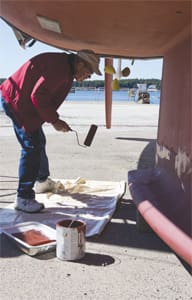Not all boat owners apply their own anti-fouling paint to their boats. But for those who do, and for those who don’t but who care about the environment, painting a boat’s underwater surfaces usually involves dealing with some heavy-duty solvents. The solvents are in the paint for keeping the coating’s pigment and biocide in liquid form so you can get them onto your boat’s hull. Not all paints use petroleum solvents, however. Another approach involves using water as the solvent for antifouling paint.
Water-based antifouling paint has been around for years, of course. These products were not widely used in previous years because, according to Don Zabransky, vice president for sales and marketing at Pettit Paint, many boat owners and boatyards apparently wondered if a water-based paint could be effective compared to traditional petroleum-solvent paints. The idea of putting a water-based paint on a boat bottom that spends the season immersed in water raised the question of whether the paint would dissolve and leave the hull unprotected. Even though that doesn’t happen with water-based antifouling paints, many boat owners chose to go with tried-and-true antifouling paints because they have worked in the past, and no boat owner wants a boat with a fouled hull. The paint industry has used solvents that are effective in holding the materials in suspension so the customer gets a paint that is easy to apply and covers well. These solvents evaporate, of course, leaving the paint’s pigment and biocide behind on the hull surface.
Typically, paint manufacturers use two types of solvents. “We use a fast solvent that evaporates quickly,” Zabransky said. “Then a slow solvent that takes a bit longer. The slow solvent helps the paint remain evenly spread as the pigment dries.”
The solvents used in paint are classified as volatile organic compounds (VOCs). VOCs have low boiling points and readily evaporate into the atmosphere. This is great for painting a boat hull, as the paint dries rapidly and the boat can be returned to the water quickly. Unfortunately, there is the other element of a VOC, the organic part. The organic components of VOCs are usually derived from petroleum and are not the types of compounds that people handle well when exposed to it in high concentrations. Plus, these compounds can react with other chemicals in the atmosphere in a variety of ways, including producing ground-level ozone. The solvents used in paints can include such materials as aliphatic hydrocarbons (methane, ethane and propane are examples of these), trimethyl benzene and others. The Federal Environmental Protection Agency (EPA) and state environmental agencies have developed rules regarding allowable concentrations of VOCs in commercial settings such as boatyards. Southern California, for example, has among the most highly regulated standards on VOC emissions. “The Southern California district is the most stringent,” said Zabransky. “Second to Southern California is Maryland.”
In Maryland, environmental rules allow each boatyard 30 pounds of VOC emissions per day, averaged over each month. When using products with traditional VOC solvents, this limits the number of boat hulls the yard can paint and still stay under VOC levels.
For paint manufacturers like Pettit, one way around VOC issues involves substituting water for VOC-based solvents. Water is not a VOC and evaporates into the air without ill effects. Thus, paint manufacturers introduced water-based antifouling paints. This is good news for boatyards in states like California and Maryland with stringent VOC rules. It means the boatyard can paint many more boats and still comply with VOC laws. It also means that, like water-based latex house paint, it is possible to clean up after a painting session with soap and water instead of paint thinner, which must be disposed of properly and can’t be just poured down the drain.
Pettit has several water-based antifouling choices in its Hydrocote line. Hydrocote is a self-polishing, dual biocide, water-based antifouling coating using copper. Hydrocote SR is a dual biocide, multi-season ablative using copper and an organic algaecide, while Hydrocote Eco is a copper-free, self-polishing ablative that uses something called an Econea dual biocide.
Interlux has a water-based paint called Fiberglass Bottomkote Aqua, and E-Paint has water-based paints such as its EP-2000 product.
If tougher VOC regulations spread to other states, these water-based antifouling paints could become a more popular bottom paint choice for boat owners and boatyards.

